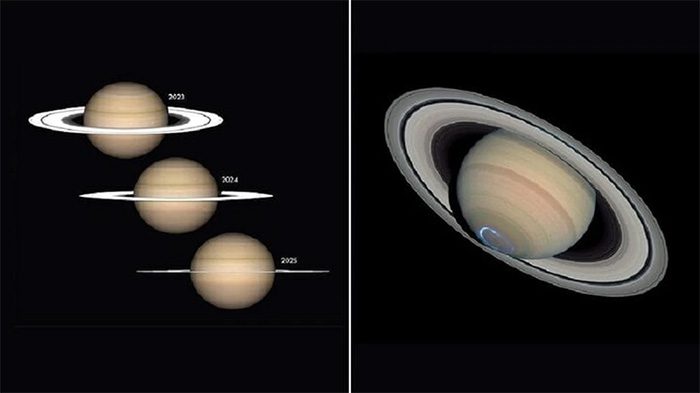According to scientists, there are only about 18 months left for humanity to observe the rings of Saturn clearly before they become “invisible.”
Daily Mail reports from the National Aeronautics and Space Administration (NASA) that astronomers and enthusiasts have just 18 months to observe Saturn’s rings before they become “invisible” in 2025.
At the time this event occurs, Saturn’s orbit will tilt toward Earth, making the observation of the planet’s rings less clear than before due to a head-on viewing angle.
Saturn’s rings are massive structures, extending from 70,000 to 140,000 km in some places. However, these rings are quite thin, only about 10 meters thick in certain areas. Therefore, when observing Saturn head-on, the rings nearly disappear when the distance between the two planets reaches 1.2 billion kilometers.

The next 18 months is the last chance to see Saturn’s rings before they disappear from view due to the planet’s tilt. (Photo: Daily Mail).
Due to its 29-year orbital cycle, Saturn will move farther from the Sun during this period.
In this cycle, we will be able to fully observe Saturn’s rings again after 13.7 to 15.7 years when the planet tilts back for a short time.
As of now, Saturn’s rings are tilted down toward Earth at an angle of 9 degrees, which will decrease to just 3.7 degrees by 2024.
The last time this rare astronomical event occurred was in September 2009, and before that, it was in February 1996.
Astronomers will not have the opportunity to observe Saturn from the current tilt angle until October 2038. However, scientists will be able to observe some of the moons among the total of 156 moons of this planet.
Though Earth passing through the viewing angle may make Saturn’s rings invisible, astronomers indicate this will be a great time to observe some of the 156 moons of the planet.
Saturn’s rings primarily consist of ice and a small proportion of rocky dust created in space from the debris of asteroids and micrometeorites colliding.
Currently, scientists believe that the rings formed from the remnants of comets, asteroids, and moons that were torn apart by Saturn’s intense gravitational forces.
The exact timing of the formation of these rings remains a topic of debate among astronomers, with competing theories suggesting they are as old as the solar system or relatively young.
Although the disappearance of Saturn’s rings this time is only temporary, scientists warn that one day these rings could vanish permanently.
Nasa’s Cassini spacecraft, which flew through Saturn’s rings 22 times before plunging into the planet in 2017, discovered that the rings are gradually disappearing at an extremely rapid rate. Cassini found that the rings are losing approximately 400 kg to 2.8 tons of mass per second.
Dr. James O’Donoghue, a planetary scientist at the Japan Aerospace Exploration Agency, stated that the astronomical community is still trying to understand the exact rate at which Saturn’s rings are eroding over time.
In a phenomenon known as “ring rain,” radiation from the Sun causes charged particles in the atmosphere.
This, in turn, causes the particles to bond with gases in Saturn’s atmosphere and be pulled away from the rings by the planet’s gravity.
Dr. O’Donoghue added, “Currently, research indicates that the rings will only be a part of Saturn for a few hundred million more years.”


















































